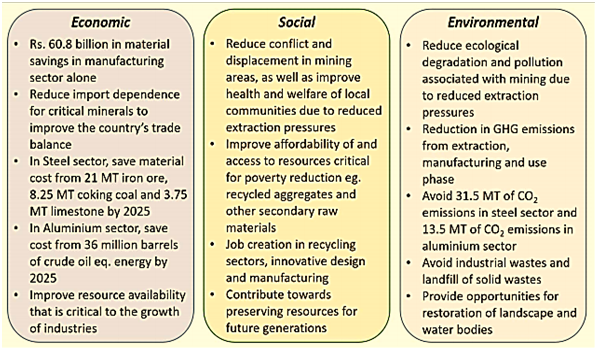Timeline Extension On Draft NREP, 2019
- 26 Aug 2019
On 26th August, 2019, the Ministry of Environment, Forest and Climate Change, acknowledging the progress that has been made to implement Draft National Resource Efficiency Policy (NREP), 2019, extended the timeline to invite comments on it till 24.09.2019.
Draft National Resource Efficiency Policy
The Draft NREP envisions a future with environmentally sustainable and equitable economic growth, resource security, healthy environment (air, water and land), and restored ecosystems with rich ecology and biodiversity.
Aim
It aims to implement resource efficiency across all resources including both biotic and abiotic resources, sectors and life cycle stages.
Guiding Principles
- Reduce primary resource consumption to sustainable levels, in keeping with achieving the Sustainable Development Goals
- Create higher value with less material through resource efficient and circular approaches
- Minimize waste creation and loss of embedded resources at the end-of-life of products
- Ensure security of material supply and reduce import dependence for essential materials
- Create employment opportunities and business models beneficial to the cause of environment protection and restoration
Salient Features of NREP
- It mandates setting up of National Resource Efficiency Authority
- (NREA) to drive the agenda of resource efficiency across the country. An inter-ministerial National Resource Efficiency Advisory Board (NREAB) will provide necessary guidance on the aspects critical to the implementation of resource efficiency across all sectors.
- Establish resource efficiency targets(based on 6Rs principles) for material recycling, reuse and landfilling targets for various sectors, in order to steer the country towards the circular economy.
- Set standards and guidelines for reuse of secondary raw materials to address concerns regarding material quality, for product design to make products more durable, make use of secondary materials, and easy to repair and/or recycle.
- Create and maintain database of material use and waste generated, recycled and landfilled, across various sectors and life cycle stages and across different regions (states/zones). To this purpose NREA will design database templates which will be fed in by concerned government agencies.
- Establish audit mechanisms with deterrent penal provisions regulated by law, which will be undertaken by the concerning government agencies.
- Provide training and capacity building to key actors responsible for undertaking or overseeing resource efficiency plans and strategies.
Resource Efficiency (RE)
- It is a strategy to achieve the maximum possible benefit with least possible resource Fostering resource efficiency aims at governing and intensifying resource utilization in a purposeful and effective way.
- It is the ratio between a given benefit or result and the natural resources use required for it.
Circular Economy (CE)
- It is an alternative to the traditional linear economy in which resources are kept in use for as long as possible, extracting the maximum value, recovering and regenerating products and materials at the end of each service life.
- Circular Economy along with RE are important goals and central principles for achieving sustainable development.
6Rs Principles
These principles arekey to drive resource efficiency and refer to:
- Reduce
- Reuse
- Recycle
- Refurbish
- Redesign
- Remanufacture
Need For Resource Efficiency in India
Current Scenario
|
Benefits of Resource Efficiency
- It brings about multiple benefits along the three dimensions of sustainable development - economic, social and environmental.

Government’s Role towards Resource Efficiency
- NITI Aayog in collaboration with the European Union delegation to India released the Strategy on Resource Efficiency in 2017. The strategy aims to promote resource efficiency in India.
- Besides, the government should:
- Set-up in house resource efficiency institution(resource efficiency cell) in their ministry/region to work and coordinate the tasks on resource efficiency in their concerned sector/region.
- Implement the resource efficiency strategies, for their concerned sector/region.
- Develop and implement policy instruments and enabling regulatory frameworks for resource efficiency in their concerned sector and/or region.
- Facilitate b relevant datasets for their concernedsector/region.
- Facilitate setting-up of infrastructure for recovery and recycling eg. setting-up of Material Recycling Zones (MRZs) that co-locate recyclers and end use producers with common facilities and shared infrastructure.
- Institutionalize product labelling requirements that include relevant information about product with information on its safe usage and disposal.
- Implement green public procurement that includes procurement of product manufactured from recycled scrap materials, use of recycled materials etc.
- Implement waste segregation at sources in all its offices, residential areas and other establishments.
- Incentivise production and consumption of resource efficient products through appropriate fiscal incentives in order to correct for market failures.
Way Forward
- Natural resources form the backbone of any economic development. Resources not only help in meeting our basic needs, but also fulfill human aspirations for a better quality of life, higher standards of living.
- Enhancing resource efficiency and promoting the use of secondary raw materials has emerged as a strategy for ensuring that the potential trade-off between growth and environmental well-being can be minimized.
- Owing to current grim situation, the NREP, 2019 seeks to create a facilitative and regulatory environment to mainstream resource efficiency across all sectors by fostering cross-sectoralcollaborations, development of policy instruments, action plans and efficient implementation and monitoring frameworks.




